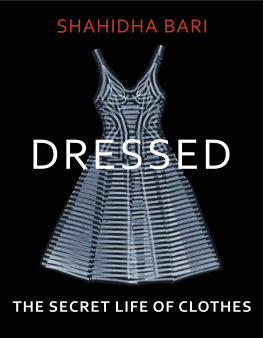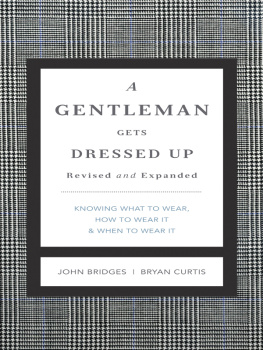
Getting Dressed
Getting Dressed teaches sociology through the everyday decision of what to wear. It is about the rules that shape how we dress and how and why we conform. It is about how and why we imitate others. We may think about clothing as our personal style and identity. But our personal style is not so personal; it is social, shaped and limited by countless social influences. We use clothes to rank and treat each other as better and worse. Yet we need each other to become who we are when getting dressed. This book is about what we wear, why we wear it, and why it matters.
Carrie Yodanis is Associate Professor of Sociology at the University of British Columbia. She is also author of Getting Married: The Public Nature of Our Private Relationships.
Getting Dressed is a truly unique book in the blooming field of fashion sociology. Using a rich array of concrete examples, Yodanis asks a simple, yet overlooked question: why do we wear what we wear? Anyone interested in fashion will enjoy her sociologically-minded answers.
Frdric Godart, Assistant Professor, Organisational Behaviour Department, INSEAD
Carrie Yadonis makes a meaningful contribution to a sociology of fashion/dress and argues convincingly that getting dressed, which appears to be a personal experience, is in fact socially controlled and influenced by a variety of external factors. I highly recommend this book to anyone interested in the sociological analysis of the way people dress.
Yuniya Kawamura, Professor, Sociology, Fashion Institute of Technology
Getting Dressed
Conformity and Imitation in Clothing and Everyday Life
Carrie Yodanis
First published 2019
by Routledge
711 Third Avenue, New York, NY 10017
and by Routledge
2 Park Square, Milton Park, Abingdon, Oxon, OX14 4RN
Routledge is an imprint of the Taylor & Francis Group, an informa business
2019 Taylor & Francis
The right of Carrie Yodanis to be identified as author of this work has been asserted by her in accordance with sections 77 and 78 of the Copyright, Designs and Patents Act 1988.
All rights reserved. No part of this book may be reprinted or reproduced or utilized in any form or by any electronic, mechanical, or other means, now known or hereafter invented, including photocopying and recording, or in any information storage or retrieval system, without permission in writing from the publishers.
Trademark notice: Product or corporate names may be trademarks or registered trademarks, and are used only for identification and explanation without intent to infringe.
Library of Congress Cataloging-in-Publication Data
A catalog record for this book has been requested
ISBN: 978-1-138-29173-7 (hbk)
ISBN: 978-1-138-29174-4 (pbk)
ISBN: 978-1-315-26508-7 (ebk)
Typeset in Adobe Caslon
by ApexCovantage, LLC
Getting Dressed is something we all do every day, and what we wear can teach us a lot about our society.
I wrote this book for people in their 20s who are interested not only in fashion, but the social world and their place in it. You dont have to dress well or shop a lot or even care about clothes to enjoy this book. If you do, or you dont, there is a lot to learn from reading it. I kept this book concise but made sure it contains a lot of information interesting to a wide audience. I cover issues of gender, race, age, sexuality, class, and the body. I incorporate theories from social psychology to social stratification. I discuss debates about fashion, consumption, and creativity. I write about how clothes get made and sold. I focus on Western societies today, but I include some international and historical examples. I present the experiences of a broad range of people and their clothes including, but not limited to, white-collar professionals, hipsters, and hip-hop artists, high school girls and Muslim women, Lolitas in Harajuku, Tokyo and outlaw bikers in North America, Burning Man attendees and punk rockers. In this book, there is a lot to debate and discuss.
This book is adoptable for a wide range of courses in sociology, including Introduction to Sociology, Sociology of Consumption, and Sociology of Culture. It is easily adaptable to courses as they are currently taught; courses do not need to change to fit the book. The focus is on ideas to debate rather than concepts and definitions to memorize. And ideally, students will read this book not only because it has been assigned to them but because they want to.
Getting Dressed is about the rules that shape how we dress and how and why we conform. It is about how and why we imitate others. We may think about clothing as our personal style and identity. But in the Western world today, our personal style is not so personal; it is social, shaped and limited by countless external influences. We use clothes to rank and treat each other as better and worse. Yet we need each other to become who we are when getting dressed. This book is about what we wear, why we wear it, and why it matters.
As Ive been writing this book, shoulders are showing everywhere. Two shoulders show with the off-the-shoulder look, a top or dress with a wide neckline pushed down the arms to leave the shoulders bare. The one-shoulder look is similar but shows one shoulder while the other remains covered. The cold shoulder style shows the shoulders through cutouts in the sleeves between the neck and arms. Shoulders appear through tops, dresses, and sweaters and on formal attire, casual outfits, and active wear.
When you are reading this, shoulders may still be showing. Maybe you just bought another shoulderless top or maybe you would still never be caught dead in one. Or, maybe by the time you are reading this, shoulders are once again covered and you hardly remember the style. Regardless, for a while, during 2016 and 2017, a lot of people wore clothes that showed their shoulders. Why?
We may start with practical reasons. Weather appropriateness is a common reason given for wearing certain clothes. As a Vogue writer explained, in the middle of a heat wave a shoulder-baring top is practical. [I] managed to stay cool on a particularly muggy, 30-minute subway excursion thanks to a crisp white off-the-shoulder blouse. It may be true that having shoulders outside of a shirt may be cooler.
Yet the style is definitely not all practical. The coolness of the style may be countered by other heat-related problems that the style creates. For example, showing shoulders creates a bra problem. A writer for the blog Jezebel shared particularly strong feelings against the shoulder-showing style. One reason she hates the style is the necessity of having to wear a strapless bra or go braless in the heat, both of which she argued are particularly uncomfortable when sweating:
Strapless bras [are] uncomfortable . This is particularly true during the summer, when the sweat makes them more susceptible to slippage . I much prefer to go braless, but then, Id like a bit of support underneath my flowy off-the-shoulder top to keep the sweat from my boobs from dripping down my stomach.








